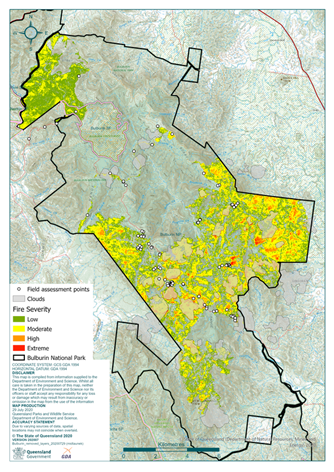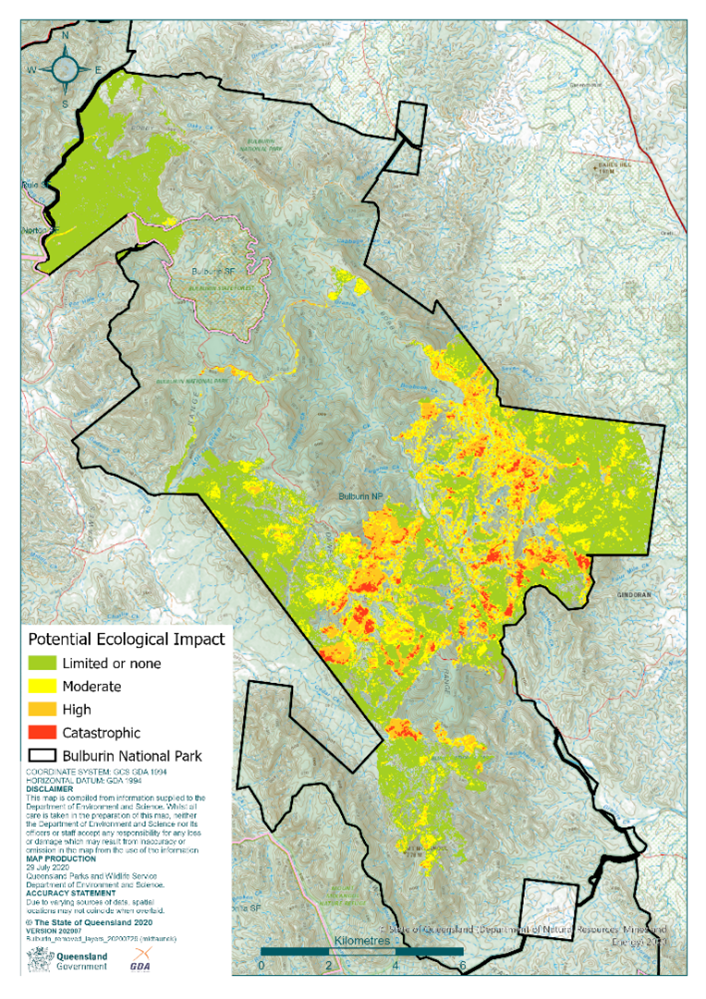Bulburin National Park—Post-fire ecological assessment
Between November 2019 and February 2020, two separate bushfires occurred in Bulburin National Park which burnt 7,542 hectares, representing 22% of the park area.
Fire severity

Across Bulburin National Park, fire severity was mostly at a low level (45%) with the understorey vegetation typically burnt, and at a moderate level (44%) with fire impacts reaching into the tree canopy. Almost 10% of the area burnt at a high level of fire severity with the tree canopy scorched or lost, and less than 1% burnt at an extreme level with complete consumption of all layers of the plant communities.
| Fire severity | Hectares |
|---|---|
| Low | 3407 |
| Moderate | 3349 |
| High | 744 |
| Extreme | 42 |
Description of effect on vegetation
- Low: canopy and subcanopy unscorched, shrubs may be scorched, fire-sensitive low shrubs may be killed.
- Moderate: partial canopy scorch, subcanopy partially or completely scorched, and/or fire-sensitive tall shrub or small tree layer mostly killed.
- High: full canopy scorch to partial canopy consumption, subcanopy fully scorched or consumed.
- Extreme: full canopy, subcanopy and understorey consumption.
Ecological impacts

The vegetation impacted by the 2019-20 bushfires was dominated by three main types: eucalypt woodlands to open forests (4,488 hectares), rainforests (2,116 hectares) and wet eucalypt open forests (915 hectares). The eucalypt woodlands to open forests have a fire-adapted canopy and understorey and, as a result, the burnt areas were mostly classified with limited or no potential ecological impact and will soon recover if future fires are infrequent. Wet eucalypt open forests have a fire-adapted canopy and typically a fire-sensitive understorey, with some areas being classified as having high or catastrophic potential ecological impact and being relatively slow to fully recover. Whilst these ecosystems can cope with an occasional high intensity fire, the preceding drought conditions would have increased the impacts and the loss of large trees which provide important habitat features, such as nesting hollows for birds and mammals.
The fires that impacted the rainforest ecosystems resulted in predictions of moderate to catastrophic ecological impact due to fire-sensitivity of both the canopy and understorey. Even at low severity, fire can have significant effects through, for example, the loss of the nutrient-rich and moist leaf litter layer and long-lived seeds. At higher levels of fire severity, the impacts can be catastrophic due to the loss of canopy trees and microclimates suitable for regeneration or germination. As a result, the recovery process is very slow, or there is no recovery resulting in the permanent loss of rainforest plant species and the fauna that depend on them.
| Potential ecological impact class | Rainforest (Fire sensitive canopy and understorey) | Wet eucalypt open forest (Fire adapted canopy and fire adapted to fire sensitive understorey) | Eucalypt woodland open forest (Fire adapted canopy and understorey) |
|---|---|---|---|
| Limited or none | 0 | 422 | 4079 |
| Moderate | 929 | 381 | 385 |
| High | 925 | 107 | 24 |
| Catastrophic | 262 | 5 | 0 |
Read the full report Post-fire Assessment Report— Natural Values: 2019/2020 bushfire, Bulburin National Park, South East Queensland Region, August 2020 (PDF, 4.4MB)